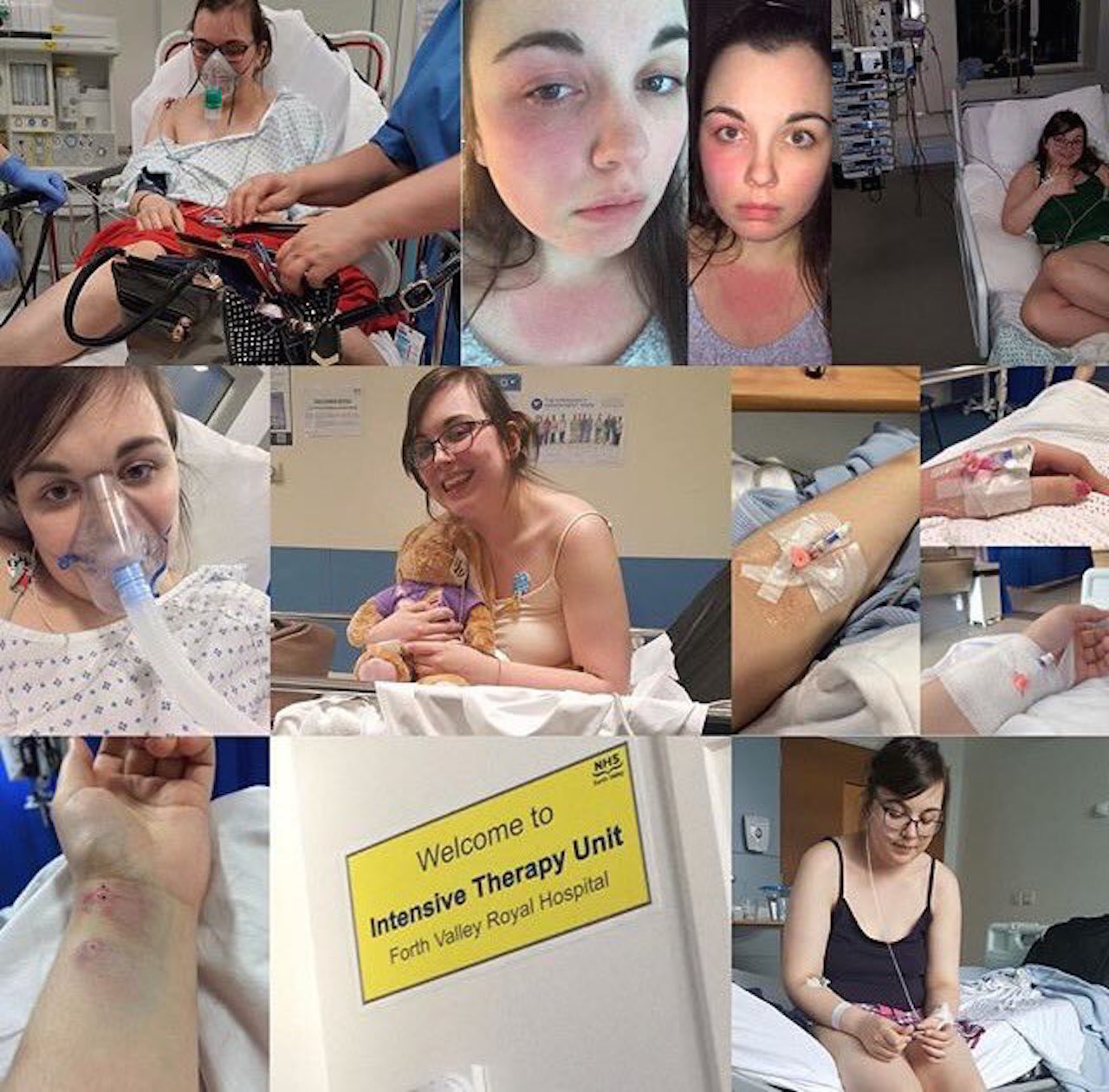I’ve struggled with allergies since the age of 5, but things escalated when I was 16 years old. I became anaphylactic to many things and allergic to many more. Anyone who knows me well enough or has been reading my blog will know that I suffer from both of these conditions.
To quickly say what anaphylaxis is: Anaphylaxis is a rare but life-threatening allergic reaction. When referring to an allergic reaction what one means is that the immune system has mistaken something as harmful, such as nuts or dust, and registers them as an intruder – something which shouldn’t be there and releases histamine. The release of histamine causes a range of symptoms, which affect different systems within the body. In patients with anaphylaxis, the main systems which are affected are the respiratory, digestive and circulatory systems. This causes a wide range of symptoms from difficulty breathing to vomiting. What is an everyday treat to the majority of people, such as peanut butter, becomes something deadly to someone with anaphylaxis.
To go onto more about my experiences with anaphylaxis, I’ve suffered a wide range of them. I’ve experienced minor reactions where within minutes I became better and within hours could go back to everyday life. However, at the opposite end of the scale, I’ve experienced reactions which have been deemed as deadly. I’ve been admitted to intensive care on various occasions, as well as high dependency, due to anaphylaxis.
What many people don’t realize or understand is that the issue isn’t just coming into contact with something that causes an allergic response. Many times I’ve experienced an episode of anaphylaxis, been given prompt medical treatment and hours to days later have become extremely unwell again, fighting for my life. These are what are known as biphasic reactions. A biphasic reaction occurs after the medication controlling the anaphylactic reaction wears off and there is still some of the allergen left in the body. And, once again, the body does everything within its power to try and get rid of it. These reactions can often be worse than the initial reaction.
Anaphylaxis is an extremely frightening condition to live with. A common misconception associated with allergies is that they are easy to live with. “Just avoid the thing you’re allergic to and you’ll have nothing to worry about,” when the reality is so much different. “May contain,” “made in a factory with,” “produced on the equipment with” are all part of the nightmare that is anaphylaxis. It’s not just about avoiding the allergen itself, but also a whole range of other things too.

I remember going into a supermarket and picking up some flavored water. I was reading the nutritional information when the allergy advice caught my eye, “May contain traces of nuts.” I put the water back down and sighed, totally frustrated. Allergies are hard enough to live with, but many companies use what is known in the allergy community as “blanket labelling.” This is where they will place allergy warnings, in particular nut allergy warnings, on everyday items that you wouldn’t think would contain the allergen. Things like juice, crisps, and even fresh fruit can often be off the tables when living with allergies because it’s too much of a risk to take. Even a small amount of the allergen protein can cause a life-threatening situation amongst people with allergies.
It’s not just food that proves to be an issue, but other everyday items too. In particular living with a nut allergy is extremely challenging and difficult. I have several allergies to things, but the hardest by far I’ve found is tree nuts and peanuts. You have to check the back of things like cosmetic products, cleaning products, and medication. All of these have the potential to contain nuts or nut oil.
Many people ask me how I do it, how I get through things. The reality is that even though I’ve been living with anaphylaxis and multiple allergies for under eight years, they’ve become such a massive part of my life that I cannot remember a life without worrying about food labels and “may contains.” I cannot remember back to when life seemed so much simpler and I didn’t constantly have to stress about what I eat, or if I have my medication with me. My allergies are a large part of my life and to some extent I became my anaphylaxis and allergies for a while. Nowadays things are easier. I’ve learned what is safe and what isn’t. Even then sometimes it isn’t enough.
In the seven years I’ve struggled with anaphylaxis I’ve experienced over 300 anaphylactic reactions, including biphasic reactions. Every reaction has put me into the hospital whether it be the emergency department receiving observation, resuscitation ending up with numerous needles and tests being performed, or critical care where I’m not sure what’s going to happen next. Numerous people think I’m extremely careless when it comes to my allergies, that I don’t avoid the things I know I cannot have – but this is far from the case. I avoid not only all the things that contain my allergies, but the “may contains” too. Unfortunately, I struggle with a very rare issue compared to most people with anaphylaxis.
My allergies constantly change. Quite literally, I can be allergic to something one day and can eat it the next. What is safe for me today may put me in the hospital fighting for my life tomorrow. That may seem like a complete over-exaggeration, but it’s the reality of my life. The biggest example of this would be my anaphylaxis to nuts. My first reaction, in August, 2010, was to hazelnuts. Afterwards I suffered reactions to peanuts, almonds and many others. Late November, 2011, I was accidentally given a meal containing nuts. I waited for the reaction to happen, but no reaction came.
After no reaction occurred I believed I was no longer allergic to nuts. My anaphylaxis no longer seemed as scary as it once was. I could eat things freely without having to worry too much. During April, 2013, I was re-diagnosed with anaphylaxis to both peanuts and tree nuts after eating some cashews and going into anaphylactic shock. It felt like my world had crumbled. I felt completely back to square one and totally alone.
“Fussy eater.”
“It’s just a peanut.”
“Don’t be so over dramatic.”
“You’re just attention seeking.”
These are all quotes from people I’ve come into contact with regarding my allergies. People don’t seem to understand the implications of anaphylaxis. I think it’s because it’s not them or someone they are close to living with the condition. They don’t understand how difficult life with allergic reactions truly is. A lot of people associate allergies with a slight rash or a sniffle, such as that of hay fever. Many people are unaware that for so many people over the world, it’s life-threatening.
Check out these important statistics from Allergy UK. Why isn’t more awareness being raised regarding this condition? Why are there still so many common misconceptions associated with this condition?
The condition affects so many people worldwide, many including children, yet still there is hardly any awareness regarding it. Allergies are not just something simple to live with. They are extremely difficult, they influence many factors of a person’s life – and not just their eating. It impacts upon where they can go, their education, their work, as well as them having what is considered to be a normal life.
Allergies can be severe. My reason behind writing this article is to hopefully give somewhat of an insight into life with an allergic condition and hopefully raise more awareness regarding this nightmare.

